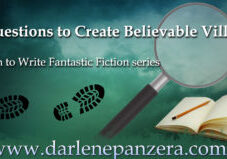5 Questions to Create Believable Villains
Last month when the weather was still warm, my daughter and I were floating around the lake on tubes and brainstorming the suspense plot of a new story. Suddenly we saw two other women staring at us and we remembered that water can carry sound further than you realize. If I overheard two people talking about the best way to murder a woman and hide her body and the murder weapon, and then frame another person to take the blame, I'd be suspicious too! LOL!
I smiled at the ladies and they smiled back, so they must have realized we were harmless. Maybe they even suspected we were writers. But brainstorming that day, led me to think of the questions we need to ask ourselves to create believable antagonists and villains.
Thank you for joining me for this adventurous Learn to Write Fantastic Fiction series!

Once you know who your main character (protagonist) is and what it is he/she wants to do, (See: 3 Goals Every Writer Must Consider) you need to figure who or what can directly oppose this goal. After all, if attaining the goal is too easy, you won't have a story. What you need is CONFLICT. Your heroic main character needs to change and grow as they pursue their goals, and it is conflict that helps him to do this. Conflict can come from a variety of sources, but today we are going to talk about the conflict that comes from other people.
A person who directly opposes the main character's goal and causes him the most trouble is called the ANTAGONIST. There may be more than one in a story, but it is important to remember that an antagonist does not have to be an evil villain or even a bad guy. You may have two people with opposing views who each have a valid reason for believing what they do. Maybe they are just fighting over the same thing, like two dogs over a bone. It doesn't necessarily mean either one of them are wrong, but they cause conflict for each other.
Then there are antagonist's who are VILLAINS. This kind of person intentionally means to cause harm to your heroic main character. A villain should have more negative traits than positive ones. But your villain shouldn't just be pure evil. He can have 3 negative traits and 1 good trait. But you need to give him at least one trait the reader can identify with to make the character believable.
Example: You can have a villain who is a pyromaniac who loves to set sheds in the neighborhood on fire. He doesn't care about others because no one has ever shown they cared for him. He especially has it in for the guy next door who he believes stole his new pack of lighters and has threatened to turn him in as a suspect. He plans to burn this neighbors shed down next. But on the positive side, this villain also has a cat at home who he allows to sleep on his lap or a kid who he will protect at any cost.
Even if his intentions are wrong, the reader also has to be able to understand why this villain thinks and acts the way he does. We need to know his motivation, his why. This is how you can keep your villain 3-dimensional and interesting, instead of what editors call a shallow "cardboard villain" who is pure evil for no valid reason. Always ask yourself how can you make your antagonist or villain different, so he isn't predictable or like other villains?
Remember too, that the scariest villains don't have to be dark or dirty with scars across their faces. Sometimes the scariest villains of all are the successful, clean cut, next-door neighbor types who the protagonist never suspected. Someone who's been hiding in plain sight.
When brainstorming an antagonist or a villain, you have to look at the story from their point of view and ask 5 basic questions: Who, What, Why, When, and Where?

I sincerely hope this helps you to start brainstorming the opposition your main character must face at a deeper level than you have in the past. If you have any questions or comments I'd love to hear from you! Just leave a message in the box below.
Until next time—Happy Writing!










